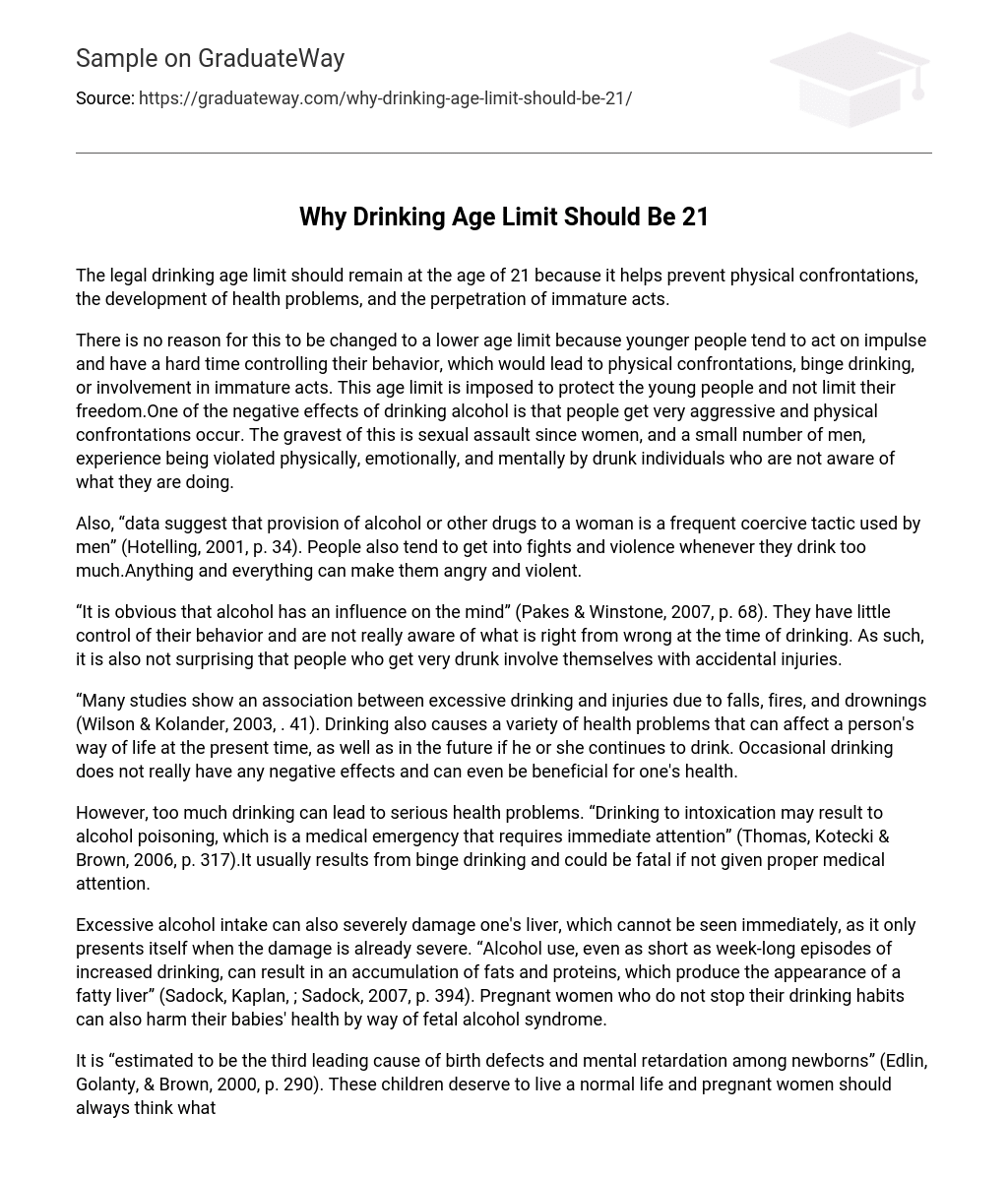The legal drinking age limit should remain at the age of 21 because it helps prevent physical confrontations, the development of health problems, and the perpetration of immature acts.
There is no reason for this to be changed to a lower age limit because younger people tend to act on impulse and have a hard time controlling their behavior, which would lead to physical confrontations, binge drinking, or involvement in immature acts. This age limit is imposed to protect the young people and not limit their freedom.One of the negative effects of drinking alcohol is that people get very aggressive and physical confrontations occur. The gravest of this is sexual assault since women, and a small number of men, experience being violated physically, emotionally, and mentally by drunk individuals who are not aware of what they are doing.
Also, “data suggest that provision of alcohol or other drugs to a woman is a frequent coercive tactic used by men” (Hotelling, 2001, p. 34). People also tend to get into fights and violence whenever they drink too much.Anything and everything can make them angry and violent.
“It is obvious that alcohol has an influence on the mind” (Pakes & Winstone, 2007, p. 68). They have little control of their behavior and are not really aware of what is right from wrong at the time of drinking. As such, it is also not surprising that people who get very drunk involve themselves with accidental injuries.
“Many studies show an association between excessive drinking and injuries due to falls, fires, and drownings (Wilson & Kolander, 2003, . 41). Drinking also causes a variety of health problems that can affect a person’s way of life at the present time, as well as in the future if he or she continues to drink. Occasional drinking does not really have any negative effects and can even be beneficial for one’s health.
However, too much drinking can lead to serious health problems. “Drinking to intoxication may result to alcohol poisoning, which is a medical emergency that requires immediate attention” (Thomas, Kotecki & Brown, 2006, p. 317).It usually results from binge drinking and could be fatal if not given proper medical attention.
Excessive alcohol intake can also severely damage one’s liver, which cannot be seen immediately, as it only presents itself when the damage is already severe. “Alcohol use, even as short as week-long episodes of increased drinking, can result in an accumulation of fats and proteins, which produce the appearance of a fatty liver” (Sadock, Kaplan, ; Sadock, 2007, p. 394). Pregnant women who do not stop their drinking habits can also harm their babies’ health by way of fetal alcohol syndrome.
It is “estimated to be the third leading cause of birth defects and mental retardation among newborns” (Edlin, Golanty, & Brown, 2000, p. 290). These children deserve to live a normal life and pregnant women should always think what is best for their babies. Lastly, people who drink too much are not aware that this is the time when they tend to engage in immature situations that they would not normally involve themselves in when they are sober.
For some reason, people who are drunk get the notion that it is okay to drink and drive.Either they feel that they are capable of driving responsibly even if they are drunk or that they are not aware that they are already drunk. “Alcohol’s ability to impair drivers’ judgment and reaction time is perhaps the most well known of these fatal effects. Drunk driving killed more than 15,000 U.
S. Residents in 1999” (Ropeik & Gray, 2002, p. 43). Also, several laws have already been imposed against public intoxication because it disrupts the public peace and might provoke violence.
Another immature act is binge drinking, which can result to “not using protection when engaging in sex, getting injured, or engaging in dangerous driving behaviors” (Edlin, Golanty, & Brown, 2000, p. 286). It is important therefore that young people understand these negative effects that alcohol can bring because this is the only way they can understand why there is a legal drinking age. The above mentioned reasons are enough to answer the question of why the drinking age limit should remain at the age of 21.





